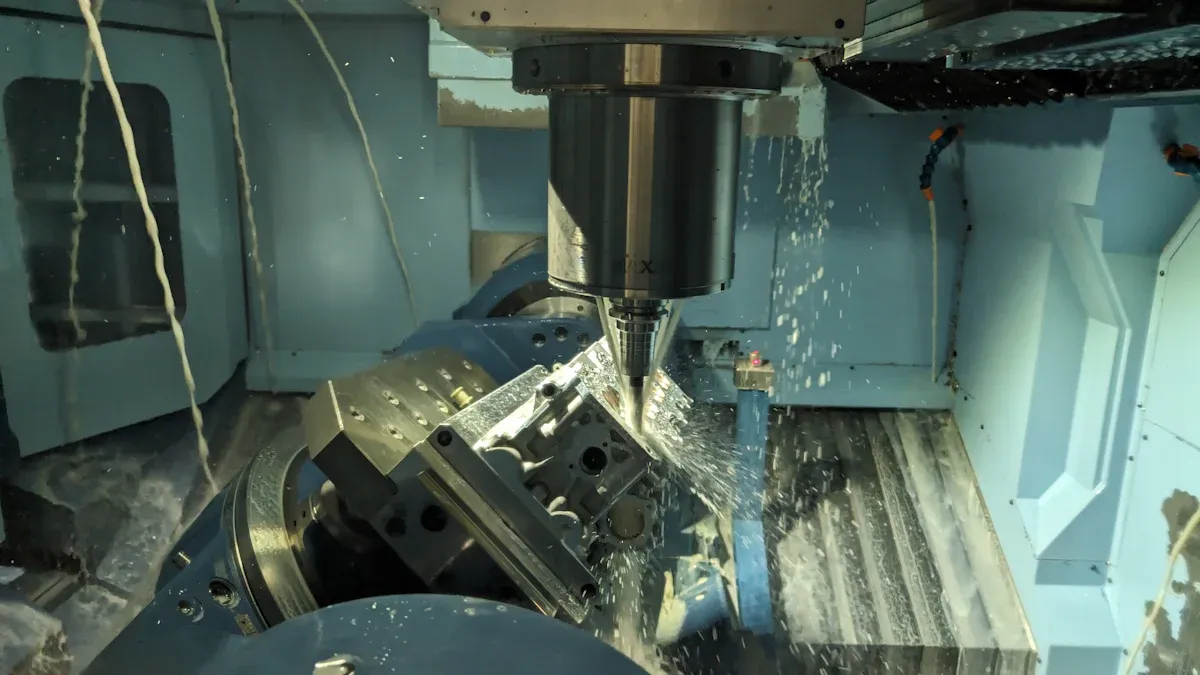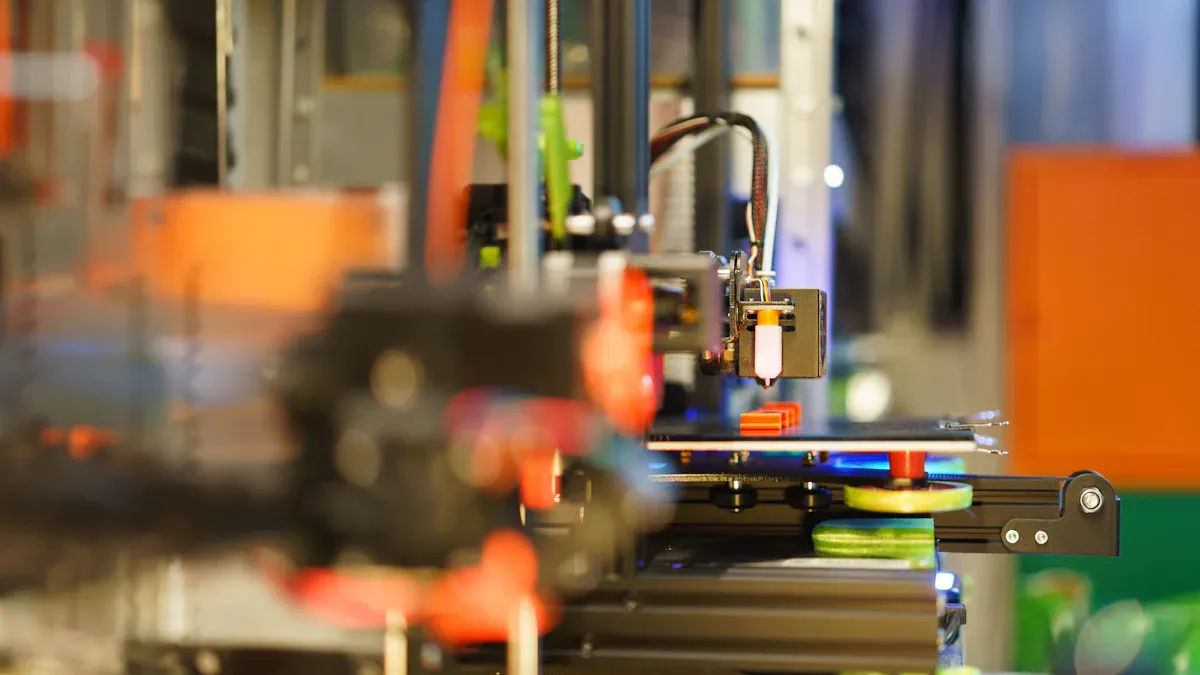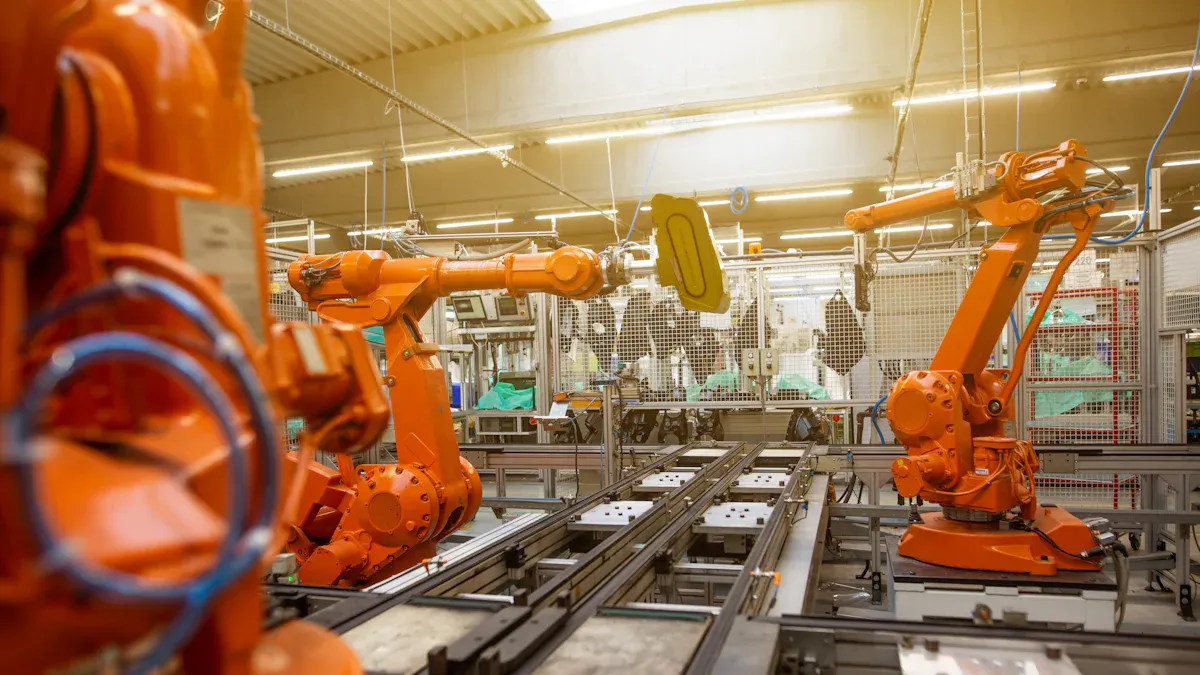
Flash occurs in injection molding when molten plastic seeps out of the mold cavity and solidifies, leaving unwanted edges. This defect often results from mold damage, excessive pressure, or improper clamping. Addressing flash is essential for producing high-quality parts and reducing waste. For example, optimizing parameters like screw speed can lower energy use by over 84%, while adjusting mold closing motion can cut cycle times by nearly 30%. By understanding these factors, you can enhance efficiency and achieve better results in your molding processes.

Flash in injection molding refers to a thin layer of excess plastic that forms along the edges of a molded part. This happens when molten plastic escapes the mold cavity and solidifies outside the intended shape. You might notice this defect as an unwanted ridge or edge on the finished product. Flash typically occurs where two mold surfaces meet, such as at the parting line. It can affect the appearance and functionality of the part, requiring additional steps like trimming or sanding to remove it.
Several factors contribute to flash. Improper clamping pressure can prevent the mold from sealing tightly, allowing material to seep out. Trapped air bubbles and uneven temperatures during the injection process can also cause this issue. Managing flash often requires extra resources, which can reduce the efficiency of your production process.
The parting line is the boundary where two halves of the mold come together. Flash defect in injection molding often appears here because this area is most vulnerable to gaps or misalignment. If the mold halves do not close properly, molten plastic can escape through the tiny openings. This is especially common when the clamping force is insufficient or when the mold surfaces are damaged.
Temperature variations also play a role. If the mold is too hot or too cold, the plastic may not flow evenly, increasing the likelihood of flash. Additionally, wear and tear on the mold over time can create imperfections at the parting line, making it harder to achieve a perfect seal. By addressing these issues, you can minimize the occurrence of plastic injection molding flash and improve the quality of your molded parts.
Understanding the causes of flash in injection molding is essential for improving product quality and reducing waste. Flash occurs due to several factors, including mold design issues, material properties, and process parameter inconsistencies. Let’s explore these causes in detail.
The design and condition of the mold play a significant role in preventing flash defects. A poorly designed mold or one that has sustained damage can lead to improper sealing, allowing molten plastic to escape. Common issues include:
- Parting line mismatch: Misalignment at the parting line creates gaps where material can seep out.
- Mold damage: Wear and tear over time can result in imperfections that compromise the mold’s ability to seal tightly.
- Improper support: A mold that isn’t adequately supported may shift during the injection molding process, causing flash to occur.
Additionally, excessive pressure in the mold cavity can exacerbate these problems. When the pressure exceeds the mold’s tonnage capacity, it forces the molten plastic into unintended areas, leading to flash formation. Regular inspection and maintenance of molds can help you avoid these issues and ensure consistent results.
The type of material used in the injection molding process significantly influences the likelihood of flash. Materials with low viscosity, such as polypropylene (PP), flow more easily and are more prone to overfilling the mold cavity. This increases the risk of flash defects. On the other hand, materials like acrylonitrile butadiene styrene (ABS) exhibit better resistance to flash under similar conditions.
Key factors to consider include:
- Viscosity: Lower viscosity materials are more likely to leak through small gaps in the mold.
- Temperature sensitivity: Higher barrel and nozzle temperatures reduce material viscosity, making it easier for the molten plastic to escape.
- Material compatibility: Some materials require specific mold designs to prevent flash.
For example, research shows that holding pressure and injection velocity significantly affect flash formation in both PP and ABS. By selecting the right material and optimizing its processing conditions, you can minimize the occurrence of excess plastic on your molded parts.
Incorrect process parameters are among the most common causes of injection molding flash. Injection speed, packing pressure, and mold temperature all play a role in determining whether flash occurs. If these parameters are not properly set, they can lead to uneven material flow and overfilling of the mold cavity.
Critical process parameters to monitor include:
- Injection speed: Higher speeds increase the likelihood of flash by forcing material into unintended areas.
- Packing pressure: Excessive pressure during the packing phase can cause overfilling and flash formation.
- Mold temperature: Uneven or inappropriate temperatures can result in inconsistent material flow, increasing the risk of flash.
Studies indicate that polypropylene exhibits more flash formation compared to ABS under similar conditions, highlighting the importance of material-specific parameter adjustments. Regularly reviewing and fine-tuning your process settings can help you reduce flash defects and improve overall efficiency.
Proper machine maintenance plays a crucial role in preventing flash during injection molding. Over time, wear and tear on machine components can lead to issues like misalignment, uneven clamping force, and poor material flow. These problems increase the likelihood of molten plastic escaping the mold cavity. By implementing a consistent maintenance routine, you can minimize these risks and maintain high-quality production.
To keep your machines in optimal condition, follow these essential maintenance practices:
Industry benchmarks suggest specific intervals for inspecting and maintaining machine components. Adhering to these schedules can significantly reduce flash occurrences:
The table below summarizes key maintenance practices and their importance in preventing flash:
| Maintenance Practice | Description |
|---|---|
| Regular Inspections | Routine checks on platen condition and functionality to prevent issues. |
| Preventive Maintenance | Scheduled maintenance to address wear and tear, including re-tapping holes. |
| Monitoring Components | Regular checks on bushings, tiebars, and lubrication systems for efficiency. |
By following these guidelines, you can extend the lifespan of your equipment and reduce the occurrence of flash defects. Consistent maintenance not only improves product quality but also enhances overall production efficiency.

A well-designed mold is one of the most effective ways to control flash. You can prevent flash by ensuring the mold fits perfectly and seals tightly during the injection process. Misaligned mold halves or worn-out components often create gaps where molten plastic escapes, leading to flash defects.
To avoid flash, focus on these key aspects of mold design:
- Parting Line Precision: Ensure the parting line is smooth and free of imperfections. Even minor misalignments can cause flash to occur.
- Venting: Proper venting allows trapped air to escape, reducing pressure buildup that can force material out of the mold cavity.
- Support Structures: Reinforce the mold to prevent shifting during the injection process.
Case studies highlight the importance of mold design improvements. For example:
- In the automotive industry, replacing worn components reduced flash by 80%, saving costs and improving efficiency.
- In consumer electronics, implementing Design for Manufacturability (DFM) and precise temperature control virtually eliminated flash, enhancing product appearance.
- In medical devices, investing in flash-free tooling and optimizing parameters improved compliance and increased production yield.
Specifying a flash-free mold during the design phase ensures better results and minimizes post-production corrections. By addressing mold design early, you can avoid flash and improve the overall quality of your injection molding process.
Fine-tuning process parameters is another critical step to prevent flash in injection molding. Incorrect settings often lead to uneven material flow or excessive pressure, both of which increase the likelihood of flash defects.
Key parameters to monitor include:
1. Injection Speed: Slower speeds reduce the risk of material escaping the mold cavity.
2. Packing Pressure: Lower packing pressure prevents overfilling, which is a common cause of flash.
3. Mold Temperature: Consistent temperatures ensure even material flow, reducing the chances of flash formation.
Empirical data supports the impact of parameter adjustments. A study involving 104 experimental runs found that 33 parts showed flash defects, while 71 conditions successfully avoided flash by optimizing process settings. The table below summarizes these findings:
| Evidence Description | Details |
|---|---|
| Experimental Runs | 104 total runs conducted |
| Flash Defects Found | 33 parts showed flash defects |
| Conditions without Flash | 71 conditions optimized |
Preventing flash through DFM and parameter optimization ensures consistent results. Regularly reviewing and adjusting these settings helps troubleshoot flash issues and maintain high-quality production.
Material selection plays a vital role in avoiding flash. Some materials, like polypropylene (PP), have low viscosity and flow easily, making them more prone to flash. Others, such as acrylonitrile butadiene styrene (ABS), resist flash better under similar conditions.
When choosing materials, consider these factors:
- Viscosity: Higher viscosity materials are less likely to seep through small gaps in the mold.
- Temperature Sensitivity: Materials that require lower processing temperatures reduce the risk of flash.
- Compatibility: Match the material to the mold design to ensure proper sealing and flow.
For example, tooling improvements like proper mold alignment and venting minimize flash when working with low-viscosity materials. Additionally, maintaining adequate clamping force during injection ensures the mold stays closed, preventing flash defects.
By selecting the right material and optimizing its processing conditions, you can achieve better results. This approach not only prevents flash but also enhances the efficiency of your injection molding operations.
Regular machine maintenance is essential for preventing mold flash during the injection phase and ensuring consistent production quality. Over time, wear and tear on equipment can lead to issues like misalignment, uneven clamping force, and poor material flow. These problems increase the likelihood of mold flash during the process. By implementing a structured maintenance routine, you can minimize these risks and maintain high-quality output.
To keep your machines in optimal condition, follow these best practices:
- Inspect mold components regularly for signs of wear or damage. This helps prevent gaps that allow molten plastic to escape.
- Clean and lubricate moving parts to reduce friction and ensure smooth operation.
- Verify the alignment of mold halves and check clamping force to avoid parting line mismatches.
- Monitor cooling systems to maintain consistent temperature control, which reduces uneven material flow.
A preventive maintenance program not only addresses potential issues but also ensures that protective devices function correctly. For example, dust and corrosion are significant contributors to equipment failure. Regular cleaning and adherence to manufacturers' instructions can prevent these problems. Industry experts emphasize that lack of maintenance often leads to flash defects and other operational hazards.
The table below highlights key maintenance practices and their benefits:
| Maintenance Practice | Benefit |
|---|---|
| Regular Inspections | Identifies wear and prevents gaps that cause mold flash during packing. |
| Preventive Maintenance Programs | Ensures equipment operates safely and reduces flash removal efforts. |
| Cleaning and Lubrication | Minimizes friction and enhances machine performance. |
By prioritizing maintenance, you can reduce the occurrence of mold flash during the process and improve overall efficiency. This proactive approach not only enhances product quality but also extends the lifespan of your equipment.
Quality control measures play a vital role in minimizing defects like flash and ensuring the production of high-quality molded parts. These measures help you identify and address issues early in the process, reducing the need for flash removal and other corrective actions.
To implement effective quality control, consider the following strategies:
- Set Clear Standards: Define acceptable tolerances for part dimensions and surface quality. This ensures consistency across all production runs.
- Conduct Regular Inspections: Use tools like calipers and microscopes to check for mold flash during the injection phase. Early detection allows you to make adjustments before defects escalate.
- Utilize Advanced Technology: Invest in automated inspection systems that use cameras and sensors to detect flash defects in real-time. These systems can identify even minor imperfections, improving accuracy and efficiency.
- Train Your Team: Provide comprehensive training to your staff on identifying and addressing flash defects. A well-trained team can spot issues quickly and take corrective action.
For example, moving workers away from energy sources and automating inspection processes can significantly reduce risks and improve safety. Compliance with industry standards, such as NFPA 70E, ensures that your operations meet safety and quality requirements.
By integrating these measures into your production workflow, you can minimize mold flash during the process and enhance overall product quality. Quality control not only reduces waste but also boosts customer satisfaction by delivering defect-free products.
Flash in injection molding often results from mold design flaws, material properties, or inconsistent processes. Addressing these issues improves product quality and reduces the consequences of flashing, such as wasted materials and additional labor. You can achieve this by optimizing mold design, adjusting process parameters, and maintaining equipment regularly.
Manufacturers have reported significant improvements through process optimizations. The table below highlights strategies and their impact on defect reduction:
| Strategy | Impact on Defects |
|---|---|
| Process Control | Reduces variability and defects through real-time adjustments. |
| Quality Assurance | Identifies and resolves issues before distribution, lowering product failures. |
| Fault Diagnosis | Targets specific issues to minimize downtime and improve yield effectiveness. |
Studies also emphasize the importance of safety and efficiency in production. For example:
- A Johns Hopkins study estimates 630 arc flash injuries occur annually in the U.S., underscoring the need for better safety measures.
- Research on low-cost safety strategies highlights the effectiveness of flashing beacons in improving safety at intersections.
By implementing these measures, you can prevent flash, enhance production efficiency, and reduce costs.
Flash usually happens when the mold halves fail to seal tightly. This can result from misalignment, insufficient clamping force, or worn-out mold components. Ensuring proper mold design and maintenance can help you avoid this issue.
You can adjust process parameters like injection speed, packing pressure, and mold temperature. These changes improve material flow and reduce the chances of flash. Regular machine maintenance also helps minimize defects without needing a new mold.
Yes, material properties like viscosity and temperature sensitivity influence flash. Low-viscosity materials flow easily and may escape through gaps in the mold. Choosing a material compatible with your mold design reduces the risk of flash.
You can remove flash defects through secondary processes like trimming or sanding. However, these steps add time and cost to production. Preventing flash during molding is more efficient and cost-effective.
Inspect molds regularly, ideally after every production cycle. Look for wear, damage, or misalignment. Frequent checks ensure the mold remains in good condition and reduces the likelihood of flash defects.